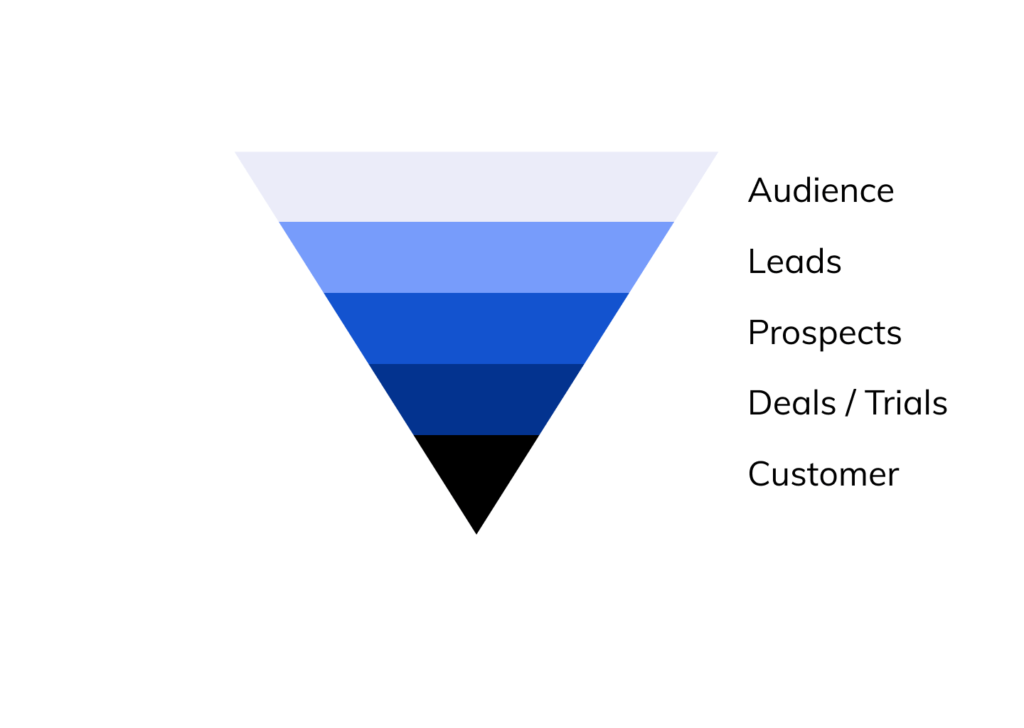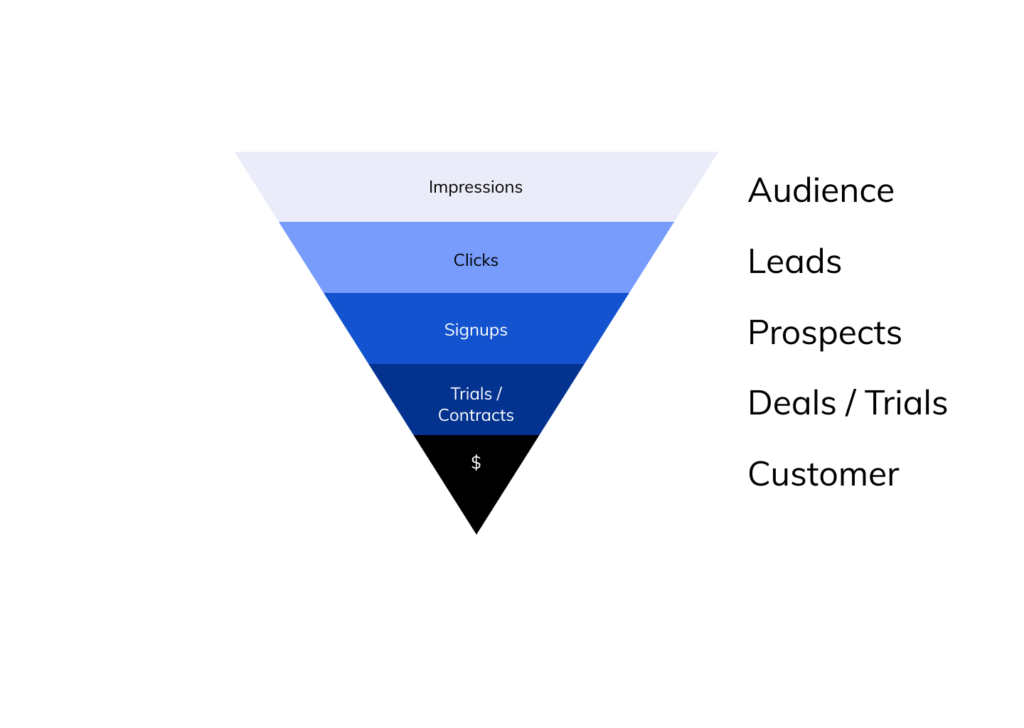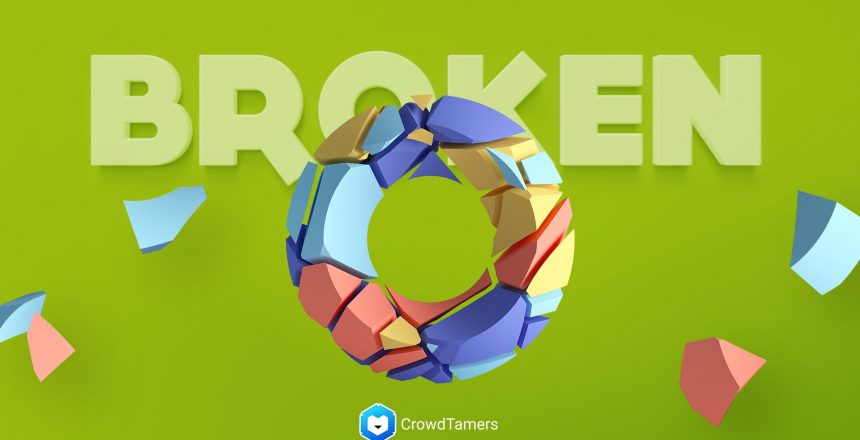Key to a good growth content marketing experiment is building a funnel which will drive audience into leads and leads into customers. If you’re not building (and testing) funnels to make your content perform for you, then you’re not doing anything I’d call growth content marketing.
Let me lead with TL;DR for the impatient:
TL;DR Fix your failing funnel in 49 words
How to know where your funnel is letting you down:
- Poor impressions = wrong budgeting
- Poor clicks on ad = wrong messaging
- Poor visits to landing page = tech failure
- Poor conversions on landing page = poor sell through of value prop
- Poor conversion into product usage = ad campaign & product don’t align
Multi-touch funnels are hard to build well, because you’re orchestrating a number of elements together. Let’s review what a multi-touch content funnel looks like:

A proper multi-touch funnel takes your audience, and converts a percentage of them into leads. My definition of lead here is “someone who’s been your website and who doesn’t have retartgeting pixels disabled.” I do this with targeted ads, often, but can just as well be distribution to an owned audience (an email list) or an earned audience (social media following, PR from a a journalist, and so on).
From there, you need to take your lead through one, two, or more touches to convert them to a prospect. A prospect is someone who’s given you their email address and some other information in exchange for something valuable that you’re giving them—a case study, a white paper, a guide, an event registration, an online course, or whatever.
Finally, you bring that prospect to either a trial or a deal that you’re negotiating**,** depending on your business model. If you offer free trials, then you have to convert the trial into a customer before you’re done with your buyer’s journey. If you negotiate more involved deals for larger average contract values, you’ll need to make sure you don’t lose your prospect then. Sometimes you have a trial followed by a deal—for the purposes of this article, it’s all pretty much the same.
Finally, you to make that trial / deal into a customer. Congrats! ?
But it doesn’t always go that way.
When good leads go bad
That is a lot of steps. And if you don’t understand what it means when your funnel fails to convert in various ways, you will not understand how to fix your funnel.
I’m emphasizing failure states here because you will not get your funnel right on the first try. Growth marketing isn’t about being right all the time. It’s about learning quickly and cheaply so you’ll be right when it counts.
So here’s your quick guide to understand what your buyers are telling you when they fail out of your marketing funnels.
What you need at each stage of the funnel
Each stage of the funnel is designed to bring the possible customer / client to the next stage via a specific action. The action varies by stage, unsurprisingly.
At the very top of the funnel. you need people to see what you want them to see. For the purposes of a Growth Content Marketing, that’s generally going to be display ads published somewhere.
Impressions are how you get your audience interested. Once they see your message, then you want clicks to bring them to your website and bring them to the lead stage. From there you will likely end up remarketing to those leads several times (as a smaller audience of highly-interested people) and bringing them back to your website several times.
Regardless, eventually you want the lead to signup and become a prospect. Once you can get the lead to pull the trigger and either try your product or negotiate a deal, they’re in the deal / trial phase, and then finally you need them to pay you and they count as a customer.

Not everyone will make it the whole way through that funnel by design. But if you can’t bring in enough people to keep your business running, your funnel is failing you.
I have good news though: the way your funnel fails you will tell you what you’re doing wrong.
Let’s diagnose those problems by funnel stage.
Audience
Not enough impressions
There are two ways your campaign can fail to reach enough impressions: not enough people or not enough money. When selecting an audience for the top of a content marketing funnel, I generally shoot for at least 10,000 but fewer than 100,000.
Not enough people
If you have fewer than 10,000 people in your marketing, you may struggle to get enough impressions to fill up the entire rest of a growth content funnel. If a combination of organic search / social media reach / owned media reach is less than 10,000 every week or two, you’ll need to supplement your free media with paid. Your growth marketing practice should run on one or two week experimentation cycles, so 10k possible impressions every cycle are a good simple target for a campaign.
If you can’t scrape together 10k possible impressions each experiment cycle, you are probably targeting too narrowly for growth content marketing. Consider if maybe account based marketing or sales-led customer acquisition could make sense for your audience.
If you’re targeting more than 100,000 people with your funnel, your persona is probably too broad. Go back and refine it before buying any paid media.
Not enough money
If you have plenty of addressable people across paid and free media but you’re unable to consistently reach them, you’re probably running into budget problems. Check into your ad platforms to see what your monthly budget caps are and if you can either increase budget or improve your ads to boost the clickthrough rate to decrease the cost per impression.
Leads
Poor clickthrough rate
“What’s a good clickthrough rate on ads” is a question in the same vein of “What’s the best flavor of ice cream?” in that it’s a highly subjective questions. Industry standard runs somewhere from 2% to 5%, but industry standards are useless without the context of “does this ad campaign make you money?”
If you are earning money on a .5% conversion rate for ads, don’t worry about industry standards. Likewise, if you can’t make money on a 10% ad clickthrough rate (CTR), then it doesn’t matter what others have done.
But if you’re just starting, you probably don’t know that info yet. So some rough metrics:
- Paid ads should see more than a 1% CTR
- For social media, roughly the same numbers apply, but be careful to note “impressions” vs. “Audience”, especially on Facebook because organic reach is extremely limited there. If you have 100,000 Facebook fans, you probably only show up to 10,000 or so of them organically.
- For email and other owned media, I’d expect CTRs higher than 5%, and possibly as high as 20% depending on your historical list engagement.
If you’re struggling to hit any of the rough metrics above, you probably have a bad fit of message to your audience. That comes back to positioning, one of the pillars of all marketing, but especially for growth content marketing.
Low visits on landing page
There is always a difference between clicks tracked in an ad platform or free media platform and what your analytics shows on your websites.
There are a number of technical reasons for that.
But if your visits are less than 50% of your clicks? Something has gone wrong, and you’ve either got an error on the ad link, the landing page, or the click attribution.
Error on the ad link
It’s an easy mistake to make, especially if you have 20 posts to prep for a week’s worth of scheduled posting. Always check the link on an ad that is mysteriously doing terribly in visits vs. CTR and make sure that maybe one variant or one channel isn’t sent to the wrong link or to a 404.
Error on the landing page
Sometimes pages go down or sometimes you get witchy stuff like local outages or NDS propagation errors. If your CTR > visits ratio is bad, double check the info at point of click (the ad or the email) and see if there’s a consistent point of failure based on geography or time of day.
Click misattribution
And probably the most common error is click misattribution, especially if you’re running campaigns across multiple channels. It could be as simple as &utm_campaign=SummerSale vs. &utm_campaign=Summersale; those won’t show up as the same campaign name in Google Analytics, so you’ll need to manually clean up that data instead.
Prospects
Landing page doesn’t convert
Here’s where your campaign lessons start to get really interesting. All of the previous errors are basically mechanical ones: you didn’t find the right people or you didn’t set up your tech correctly. If you get people to come to your page but you just can’t get them to give you their email address, now you’ve got a fun marketing problem to solve!
If the ad offer was intriguing but the landing page didn’t clinch the deal, to convert the lead into a prospect, then you need to reflect on where your landing page doesn’t further the story that brought the lead to you.
Storytelling in 12 words or fewer.
I like to think of the relationship between an ad and a landing page as a structure similar to a joke: a good joke starts with the setup and takes you to the punchline. If the punchline and the setup aren’t matched, the joke won’t get a laugh.
My son is 5 and we practice telling very short jokes. A few good ones, by a 5 year old’s judgement:
What’s orange and sounds like parrots? Carrots.
What do you call a fish with no eyes? A fsh.
What are the strongest days of the weak? Saturday and Sunday, because the rest are weak days.
You tell a few jokes like this—short with a fast punchline—and you set an expectation that the next joke will be a quick setup to a bad pun. Break the rhythm with
Why was six afraid of seven? Because seven has cold, dead eyes.
And suddenly you don’t get the laugh (this is also a metatextual joke that requires that you know the usual punchline for “Why was six afraid of seven” and a 5 year old doesn’t.).
If your landing page doesn’t make you leads, think about what the setup for the page is—the ad. What is your ad promising that your landing page doesn’t deliver? What rhythm can you establish to help your leads easily understand what you do and what’s expected of them?
Your ad has 12 words or fewer to bring a lead to your landing page. Make sure you’re not confusing them once they’ve made the click.
Deal / Trial
Bad journey
If you’ve gotten someone nurtured all the way through a funnel to this stage and you can’t get them to trial your product or start a deal discussion, you’ve got marketing that’s doing its job to get you contacts who should be very well qualified potential business. But sometimes marketing misses the mark, and after doing all of this work discovers that it has created a acquisition channel for the wrong kind of customer.
Good news: you have a great marketing engine. Bad news, you’ve hooked it up to the wrong car. ?
Take the lessons you’ve learned about building the funnel that’s gotten you this far and apply it to a new audience; you’re at least one step ahead of the game if this is your failure point, so it should be smoother sailing once you’ve found the right top to your funnel.
Vague positioning or CTA
Variously, you may have the exact right audience but you’re not focusing on a clear enough problem and message to get them to actually try you out. Yeah, they like your content and have engaged with it a number of times, but just never saw the need to actually try out your product. Refine your offer and your persona and make sure that you’re including clear CTAs to try you out where appropriate.,
Customer
Can’t close the deal
Finally, you may find your funnel fails at the very last step: conversion from prospect to either a trial or an actual customer. This is another case for introspection: take the time to analyze your prospects and see if you can find a common point of failure. Do your prospects not convert because you haven’t explained the value of your offer clearly enough to make them willing to pay? Is your offer a nice to have instead of a must have? Do you need to work harder at showing your prospect that you do, indeed, solve the problem that they gave your their contact info because they believed you’d solve it?
Being unable to close the deal after all of the above steps means your offer was either not valuable enough or your ads and landing pages didn’t align with the actual offer you present. In either case, it’s a big problem and likely will cause all of your advertising efforts to fail until you’ve solved it.
Any questions? Comments about your own funnel? Hit me up via email or Twitter and I’m happy to chat. 🙂



